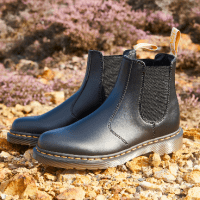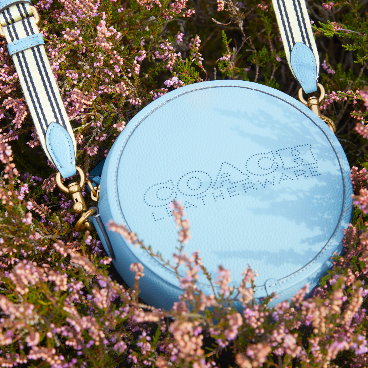
We still have a couple of winter months to get through, so now is the time if you haven't already to grab your winter coat. Whether your old favourite is coming out of wardrobe hibernation, or you’re investing in a new style for the season, your coat deserves some TLC as it sees you through the cold.
A good quality coat will see you through year after year, but only if you care for it properly. Instructions can be confusing and the fear of damaging an expensive piece can be overwhelming, so we’ve made it nice and simple. Here’s our ultimate winter coat care guide.

#1 Wax Jackets
An ideal option for the bridge between autumn and winter, a wax jacket is our go-to for rainy days. And what do you think of when you think wax jackets? A classic Barbour.
Barbour jackets don’t look too heavy so are the perfect winter coat to transition from country walks to city strolling, looking just as smart in either setting. Their wax coating makes them totally waterproof, but they need to be cared for. A worn or cracked wax coating definitely won’t be waterproof, so before the weather takes a turn it’s definitely time to ensure your jacket is on the top of its game.
How can I get my Barbour re-waxed?
Barbour recommends getting your coat re-waxed once a year to keep the quality at its highest. You can also get your inner lining, cuffs, collars and zips repaired proving that a Barbour coat really is for life if you take care of it. For only £35 you can send your jacket off to Barbour for it to be re-waxed at their South Shields HQ and returned to you within 14 days.
Can I re-wax my Barbour at home?
Alternatively, you can go the DIY route by buying some of their Thornproof Wax Dressing. Warm it up and smooth over the who jacket with a sponge, paying particular attention to areas that get worn a lot like seams and elbows, and making sure to stay away from the inside lining and collar. Blast it with a hairdryer to ensure a smooth finish then hang it up and allow to dry overnight.
For a general wash, clean the exterior of the coat with cold water and a sponge. Using warm water, harsh soaps or scrubbing will wear the wax much quicker.

A Buyer's Guide to Barbour Jackets
For over 125 years, Barbour has continued to put Britain on the map for its outerwear offering, in particular its signature wax jackets. From composition to cleaning and sizing to styles, here's the ultimate buyer's guide to Barbour jackets.
#2 Puffer Jackets

For when the weather gets really harsh, a puffer jacket is our winter coat hero. Uber insulated and cosy, there’s nothing quite like turning yourself into a pillow of warmth on a frosty day. However, while their weight makes them a cold weather saviour, it also makes them notoriously hard to wash.
How often should I wash my puffer jacket?
The most important thing here is to not wash them too much! Once a year is perfect for a puffer, so try not to exceed this. If you get a mark, simply wipe the exterior gently, but avoid washing unless necessary.
How do I wash my puffer jacket?
When the time for a full wash does roll round, care has to be taken. Though it's tempting with a pricier piece, don’t hand wash your puffer. You’ll never manage to fully wash out all the soap and chances are the coat will become far too heavy to handle, so leave it up to a machine.
For a coat with a detachable down lining, like Parajumpers, wash the elements separately to avoid any colour running or fading. You can be a lot rougher with your down lining than you can with your exterior, so it’s best to handle them separately.For the exterior jacket, wash it inside out at no higher than 30 degrees on a gentle wash. Avoid harsh soaps and don’t leave it sitting in the machine. Avoiding rubbing or soaking to keep the colour looking its best.
For the down lining, or for coats that don’t have a detachable lining like your favourite Pyrenex or North Face puffer, start by washing on a gentle wash at no more than 30 degrees. Then here’s the important part; put it in the drier on a low heat setting and spin thoroughly. You may even want to spin it a couple of times as you want to ensure that the interior is totally dry to avoid any rotting, especially with feather linings.To keep your jacket puffy and maintain the weight of the coat, throw a couple of clean tennis balls in with it during the washing and drying process, yes really. The tennis balls will avoid the coat from becoming saturated with water and ensure that the down lining doesn’t clump, keeping it separated and moving within the coat to keep your puffer jacket as puffy as possible. Once it’s done, get that coat out of the machine and hung up asap to avoid any shrinking.
#3 Faux Fur
Faux fur is incredible. In 2019 it's practically undetectable from real fur in quality, look and feel. It even has huge benefits when it comes to garment care, as faux fur is resistant to insect damage and will gather far less dirt and dust when it's waiting in your wardrobe. However, it definitely has different care requirements to protect and preserve the fibres of your faux fur linings and trips.
How do I wash my faux fur coat?
Unlike the rest of your collection, a faux fur coat is definitely one to leave to the dry cleaners when it needs a full clean. As with the others, avoid doing this until its necessary, simply give it a big wash right before you hang it up for the summer so it's fresh and ready when next year's chill suddenly comes round.

How do I clean my faux fur coat?
For a spruce up during the cold months, you should treat your faux fur winter coat like you would treat your own hair, giving it a pamper every now and then. If your coat begins to feel knotty or matted, or simply less fluffy than usual, you can give it a blow-dry. Mix a spoonful of hair conditioner in with some luke-warm water and use a spray bottle to spray this all over your coat. Using a wet hairbrush, something like a tangle teaser, comb through the coat in the direction that the fur should fall. Treat it with some kindness and be gentle. Then with your hairdryer on a cool setting, gently blast the coat to bring some life back to the fibres and restore the fluffiness you love. Easy right?
#4 Wool

A good wool coat is such a staple, adding some formality and tradition into your winter coat collection. A wool coat can last forever if you take good care of it, so pay attention when washing this one.
Is it okay to wear a wool coat in the rain?
The thing to note is that wool really doesn’t like being wet, so a key care tip is to avoid wearing your favourite wool coat on a rainy day. If you do get caught unexpectedly, or happen to spill something on your coat, try to blot the moisture away with a towel as quickly as possible.
How do I clean my wool coat?
For a quick clean up, the best thing is to give your coat a once-over with a suede brush, ideal for getting rid of any lint or dirt without tugging on the fibres. Once you’ve done this, use a lint roller to pick up any stubborn flecks or hairs left behind, and it will look near enough new again.
How should I store my wool coat?
An easy way to keep your wool coat looking its best is to always keep it on a sturdy hanger when you’re not wearing it, and avoid hanging it on a clothes peg. This will help the coat stay in shape and rigid, avoiding any knicks or misshaping around the collar.
When it comes back round to summer, keep your beloved wool coat on a strong hanger and a garment bag, and your it will sleep happily through to next winter, protected from dust or insect damage.
How do I wash my wool coat?
When it comes time to give your wool coat a thorough wash, read the care instructions. Some wool coats are strictly dry clean only, and some may need hand washing. For hand washing, get a super gentle detergent made for wool and only use cold water. Soak the coat for no more than 5 or 10 minutes, then rinse, again with cold water only.
To dry the coat, shape it into the shape it's intended to fall into with no folds or creases and lay on a thick towel. Leave it there to air dry and it will be sparkling clean.
If you’re ever in doubt, check the care instructions carefully, or ask a dry cleaner, telling them about the coats specific materials.










